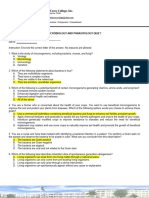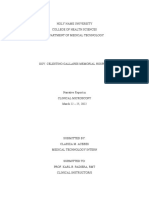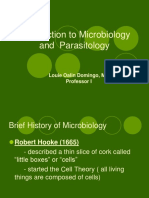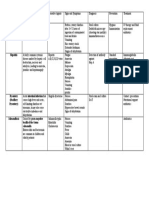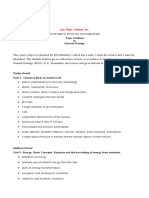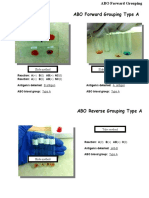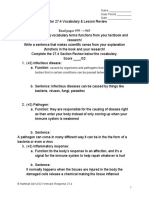Microbiology and Parasitology: Aim High Colleges, Inc
Microbiology and Parasitology: Aim High Colleges, Inc
Uploaded by
Arfaida LadjaCopyright:
Available Formats
Microbiology and Parasitology: Aim High Colleges, Inc
Microbiology and Parasitology: Aim High Colleges, Inc
Uploaded by
Arfaida LadjaOriginal Description:
Original Title
Copyright
Available Formats
Share this document
Did you find this document useful?
Is this content inappropriate?
Copyright:
Available Formats
Microbiology and Parasitology: Aim High Colleges, Inc
Microbiology and Parasitology: Aim High Colleges, Inc
Uploaded by
Arfaida LadjaCopyright:
Available Formats
Aim High Colleges, Inc.
National Highway, Buluan, Ipil, Zamboanga Sibugay
Final Examination
in
Microbiology and Parasitology
Name: Score: i
Course and Section: Date: i
Test I- Multiple Choice
Encircle the correct answer which corresponds to the given question.
1. This term is used to refer to the sum of all chemical reactions within a living organism.
A. catabolism B. metabolism C. anabolism D. biosynthetic
2. What is the correct term of FAD in coenzymes.
A. flavin adenine dinucleotide B. flavin adenosine dinucleotide C. flavin amine dinucleotide D. flavin apoenzyme dinucleotide
3. It specifically act on strands of RNA by removing sections and splicing together the remaining pieces.
A. inhibitor B. ribosomes C. ribozymes D. photophosphorylation
4. These microorganisms are capable of growth at high temperature of 50-60℃, about the temperature of water from a hot water tap.
A. hypermesophile B. hyperthermophiles C. mesophiles D. thermophiles
5. These microorganisms have adapted so well to high salt concentrations that they actually require them for growth.
A. Extreme halophiles B. obligate halophiles C. facultative halophiles D. halophiles
6. These microorganisms do not require high salt concentrations but are able to grow at salt concentrations up to 2%, a concentration that
inhibits the growth of many other organisms.
A. Extreme halophiles B. obligate halophiles C. facultative halophiles D. halophiles
7. This is one of the methods in preserving microbial cultures wherein the process of a pure culture of microbes is placed in a suspending liquid
and quick frozen at temperatures ranging from -50℃ to -95℃.
A. Deep-freezing B. freeze-drying C. refrigerating D. lyophilization
8. An organism where its genetic makeup is the information that codes for all the particular characteristics of the organism.
A. genotype B. phenotype C. chromosomes D. genes
9. It refers to actual, expressed properties, such as the organism have the ability to perform a particular chemical reaction.
A. genotype B. phenotype C. chromosomes D. genes
10. The earliest documented case of AIDS in 1959 is a patient from what country.
A. Zambia B. Algeria C. Zaire D. Zimbabwe
11. The scientific study of disease.
A. epidemiology B. pathogenesis C. etiology D. pathology
12. The manner in which a disease is developed is called .
A. epidemiology B. pathogenesis C. infection D. etiology
13. These are microorganisms that establish more or less permanent residents (colonized) but do not produce disease under normal condition.
A. microbial antagonism B. transient microbiota C. microbiota D. normal flora
14. The relationship between the normal microbiota and the host.
A. symbiosis B. commensalism C. mutualism D. parasitism
15. One of the organisms is benefited and the other is unaffected.
A. symbiosis B. commensalism C. mutualism D. parasitism
16. It is a type of symbiosis that benefits both organisms.
A. symbiosis B. commensalism C. mutualism D. parasitism
17. The term for the treatment of cancer by immunological means is .
A. immunodeficiency B. immune curate C. immunotherapy D. immunosuppression
18. This is the most dangerous form of sexual contact in transmitting AIDS.
A. Anal-receptive intercourse B. vaginal intercourse C. oral-genital contact D. transplacental infection
19. This infection devastates the immune system, which is then unable to respond effectively to pathogens.
A. AIDS B. HIV infection C. Malaria D. Influenza Virus
20. Kissing is not known to transmit the viruses of AIDS due to the lowest virus occurs during the contact. How many viruses occur in per
milliliter of saliva fluid?
A. 0.5 per mL B. 1 per mL C. 2 mL D. 3 mL
Test II – Explanation
1. Explain the significance of Scientific Research in the AIDS Epidemic. (10 points)
2. Define metabolism. (10 points)
3. Distinguish between catabolism and anabolism. How are these processes related? (10 points)
4. Differentiate AIDS and HIV. (10 points)
5. Compare and contrast aerobic and anaerobic respiration. (10 points)
6. Describe the chemical reactions of, and list some products of, fermentation. (10 points)
7. Write a summary of energy production mechanisms. (20 points)
Prepared by:
Miss Arfaida A. Ladja
Name of Lecturer
You might also like
- Solution Manual For Human Anatomy Physiology Laboratory Manual Cat Version 11 e 11th Edition Elaine N Marieb Susan J Mitchell Lori A SmithDocument7 pagesSolution Manual For Human Anatomy Physiology Laboratory Manual Cat Version 11 e 11th Edition Elaine N Marieb Susan J Mitchell Lori A SmithMelissa DavidsonNo ratings yet
- Micropara Lab Reviewer MidtermsDocument15 pagesMicropara Lab Reviewer MidtermsJustine Nicole100% (1)
- Module 4 The Calling of A Healthcare ProviderDocument6 pagesModule 4 The Calling of A Healthcare Providercoosa liquorsNo ratings yet
- Community Organizing Participatory Action ResearchDocument4 pagesCommunity Organizing Participatory Action ResearchJon EricNo ratings yet
- Moving Exam ParasitologyDocument10 pagesMoving Exam ParasitologyDayledaniel SorvetoNo ratings yet
- CPHM 121 StudentsDocument2 pagesCPHM 121 StudentsMaj Blnc100% (1)
- PSM Park MCQsDocument91 pagesPSM Park MCQsGIST (Gujarat Institute of Science & Technology)82% (28)
- Microbiology Parasitology Long Quiz MirasDocument3 pagesMicrobiology Parasitology Long Quiz MirasMarinel Miras0% (1)
- Final Exam Micropara 101 Lab 2020 2021 Microbiology and Parasitology Lab PDFDocument24 pagesFinal Exam Micropara 101 Lab 2020 2021 Microbiology and Parasitology Lab PDFJuliana MendozaNo ratings yet
- Microbiology and Parasitology Laboratory Activity No.1Document8 pagesMicrobiology and Parasitology Laboratory Activity No.1Eloisa BrailleNo ratings yet
- Test Questions PNSDWDocument4 pagesTest Questions PNSDWDianne Kristine AvilaNo ratings yet
- Trematode Lec QuizDocument2 pagesTrematode Lec QuizCia Lomh0% (1)
- Microbiology and ParasitologyDocument59 pagesMicrobiology and ParasitologyJade BuriNo ratings yet
- Anatomy and Physiology With Pathophysiology TransesDocument10 pagesAnatomy and Physiology With Pathophysiology Transeshezekiah minNo ratings yet
- Histopathology P1 & P3Document16 pagesHistopathology P1 & P3Reizel GaasNo ratings yet
- Introduction To Cell PhysiologyDocument39 pagesIntroduction To Cell Physiologywaqas_xsNo ratings yet
- Clinical Parasitology Trans 07 Lecture PDFDocument14 pagesClinical Parasitology Trans 07 Lecture PDFSt. DymphaMaralit, Joyce Anne L.No ratings yet
- MEDICAL TECHNOLOGY LAWS AND BIOETHICS Chapter 8Document46 pagesMEDICAL TECHNOLOGY LAWS AND BIOETHICS Chapter 8marie judimor gomezNo ratings yet
- Micropara: Chapter 4 NotesDocument5 pagesMicropara: Chapter 4 NotesPatrick JuacallaNo ratings yet
- Chapter 32: Nursing Care of A Family With A School-Aged ChildDocument10 pagesChapter 32: Nursing Care of A Family With A School-Aged ChildJordan GougerNo ratings yet
- Exam in Microbiology and Parasitology I CDocument3 pagesExam in Microbiology and Parasitology I CJoycee Bo100% (2)
- Biostatistics - Prelim TransesDocument7 pagesBiostatistics - Prelim TransesLOUISSE ANNE MONIQUE L. CAYLONo ratings yet
- The Cestodes: What'S AheadDocument26 pagesThe Cestodes: What'S AheadsfefsadNo ratings yet
- Micro para Lab HandoutsDocument9 pagesMicro para Lab HandoutscaraNo ratings yet
- Micro para The IntroductionDocument51 pagesMicro para The IntroductionknotstmNo ratings yet
- College of Medical Laboratory Science Our Lady of Fatima University-VelenzuelaDocument33 pagesCollege of Medical Laboratory Science Our Lady of Fatima University-VelenzuelaClaire GonoNo ratings yet
- Ra 5527Document4 pagesRa 5527juris surgeonNo ratings yet
- Medical ProtozoologyDocument6 pagesMedical ProtozoologyRaymund MontoyaNo ratings yet
- NCM 113 Topic 1 MidtermDocument3 pagesNCM 113 Topic 1 MidtermYessamae JinangNo ratings yet
- Course Syllabus - CPH LabDocument2 pagesCourse Syllabus - CPH LabTom Anthony Tonguia100% (1)
- Microbiology and Parasitology - Prelim Quiz 1Document3 pagesMicrobiology and Parasitology - Prelim Quiz 1Mary Grace MartinNo ratings yet
- Extraintestinal Cestodes QuizDocument1 pageExtraintestinal Cestodes QuizMaria Seleena HipolitoNo ratings yet
- Clinical Parasitology Mid Term TransDocument11 pagesClinical Parasitology Mid Term TransBelle LatNo ratings yet
- CHN ExaminationDocument13 pagesCHN ExaminationkathNo ratings yet
- Anaphy Practice TestsDocument6 pagesAnaphy Practice TestsHenie Louise Hinanay100% (2)
- Clariza ACEBES - Narrative Report 3rd RotationDocument6 pagesClariza ACEBES - Narrative Report 3rd RotationJung Soo Mi100% (1)
- Anatomy & Physiology PrelimDocument40 pagesAnatomy & Physiology Prelimkenneth loNo ratings yet
- CPH Lec ReviewrDocument24 pagesCPH Lec ReviewrCresma Santa Rayjane DesamparoNo ratings yet
- MNP Ch16 18Document11 pagesMNP Ch16 18Lyra Ortega OliquinoNo ratings yet
- Anatomy Prelim Answer KeyDocument8 pagesAnatomy Prelim Answer KeyDominic DinioNo ratings yet
- MICRO Lecture 1 Introduction To Microbiology and Parasitology 1 PDFDocument29 pagesMICRO Lecture 1 Introduction To Microbiology and Parasitology 1 PDFJireh AcabalNo ratings yet
- Micro-Para Finals ReviewerDocument14 pagesMicro-Para Finals ReviewerFatima Mae MeLagroNo ratings yet
- Activity 2 Gram StainDocument5 pagesActivity 2 Gram StainDivina Gracia Vibal CieloNo ratings yet
- Hes 032 Lec Long Quiz 1 BSN 2 A11Document24 pagesHes 032 Lec Long Quiz 1 BSN 2 A11Sabrina MascardoNo ratings yet
- ISUI-NUR-Syl-Effectivity: September 7, 2020 Revision: 2Document6 pagesISUI-NUR-Syl-Effectivity: September 7, 2020 Revision: 2cara100% (1)
- Alvine Discharge DiseasesDocument1 pageAlvine Discharge DiseasesApril Rose AlivioNo ratings yet
- Prelims Micropara LecDocument14 pagesPrelims Micropara LecBSN1F- JACILDO, KUH KYLA C.No ratings yet
- Copar DocumentationDocument58 pagesCopar DocumentationJessa BorreNo ratings yet
- NCM 108 Health Care Ethics MidtermDocument70 pagesNCM 108 Health Care Ethics MidtermMaria Arlyn Lacuña SagosoNo ratings yet
- Module 1 Cellular AberrationDocument12 pagesModule 1 Cellular AberrationChrizelle Florentino100% (1)
- Pmls 1 Final Exam Reviewer: Clinical Chemistry ContDocument14 pagesPmls 1 Final Exam Reviewer: Clinical Chemistry ContPlant in a PotNo ratings yet
- DAVAODocument11 pagesDAVAOJanna Janoras Ű67% (3)
- Unit 5 Test - Muscular SystemDocument5 pagesUnit 5 Test - Muscular SystemAmanuelNo ratings yet
- 1microbiology PRELIM-merged PDFDocument134 pages1microbiology PRELIM-merged PDFHelping HandsNo ratings yet
- Microbiology ReviewerDocument16 pagesMicrobiology ReviewerAnna CastroNo ratings yet
- NCMC103 Prelims ReviewerDocument13 pagesNCMC103 Prelims ReviewerVeronica ShaneNo ratings yet
- Chapter 4: Microbial Diversity: Part 1: Acelluar and Prokaryotic MicrobesDocument48 pagesChapter 4: Microbial Diversity: Part 1: Acelluar and Prokaryotic MicrobesMudarab AliNo ratings yet
- Nursing Drills 2Document27 pagesNursing Drills 2Jocy CruzNo ratings yet
- CPH Lab - Prelim TransesDocument4 pagesCPH Lab - Prelim TransesLOUISSE ANNE MONIQUE L. CAYLONo ratings yet
- Biology Model Examination For Grade 12 in The Year 2007 E.CDocument15 pagesBiology Model Examination For Grade 12 in The Year 2007 E.CDanielNo ratings yet
- Bio 2 ModelDocument16 pagesBio 2 Modelhmmea152No ratings yet
- Topic Outlines In: Aim High Colleges, IncDocument2 pagesTopic Outlines In: Aim High Colleges, IncArfaida LadjaNo ratings yet
- Topic Outlines In: Aim High Colleges, IncDocument2 pagesTopic Outlines In: Aim High Colleges, IncArfaida LadjaNo ratings yet
- Aim High Colleges, Inc.: General ZoologyDocument2 pagesAim High Colleges, Inc.: General ZoologyArfaida LadjaNo ratings yet
- LADJA-Summary of Silent SpringDocument5 pagesLADJA-Summary of Silent SpringArfaida Ladja100% (1)
- Morning in Nagrebcan by ManuelDocument1 pageMorning in Nagrebcan by ManuelArfaida LadjaNo ratings yet
- PorosityDocument1 pagePorosityArfaida LadjaNo ratings yet
- Synopsis and ReflectionDocument2 pagesSynopsis and ReflectionArfaida LadjaNo ratings yet
- Historicist Conceptions of RationalityDocument17 pagesHistoricist Conceptions of RationalityArfaida LadjaNo ratings yet
- NCP Risk For InfectionDocument2 pagesNCP Risk For Infectionnj_pink08179460% (5)
- Bacteria Characteristic NotesDocument4 pagesBacteria Characteristic NotesCamella Beatrice Lujan ValleNo ratings yet
- Covid19 Bolivia DVCDocument4 pagesCovid19 Bolivia DVCDanna VillcaNo ratings yet
- Clinical Aspects Fluor Albus of Female and Treatment: Literature ReviewDocument11 pagesClinical Aspects Fluor Albus of Female and Treatment: Literature ReviewDafit VdayNo ratings yet
- Karol The Great Plague 15 01 15Document4 pagesKarol The Great Plague 15 01 15api-276953527No ratings yet
- Streptoococcal PathogensDocument2 pagesStreptoococcal PathogensFrankiesgirl6yrNo ratings yet
- Brosur Healgen Hiv CassetteDocument2 pagesBrosur Healgen Hiv Cassetteeragonslam cyuiNo ratings yet
- Daftar PustakaDocument7 pagesDaftar PustakaArif ZainudinNo ratings yet
- ABO Grouping BB LabDocument5 pagesABO Grouping BB LabSuneth Kaye JavellanaNo ratings yet
- HepatitisDocument8 pagesHepatitisudaybujjiNo ratings yet
- Pentavalent Vaccine Guide For HWs With Answers To FAQsDocument8 pagesPentavalent Vaccine Guide For HWs With Answers To FAQsVamsidhar KavikondalaNo ratings yet
- Detachment, Distinguishing Proof of Bacterial Pathogens From Infected Shing (Heteropneustes Fossilis) Cultured in Freshwater Ponds in BangladeshDocument7 pagesDetachment, Distinguishing Proof of Bacterial Pathogens From Infected Shing (Heteropneustes Fossilis) Cultured in Freshwater Ponds in BangladeshOpenaccess Research paperNo ratings yet
- Tobacco Mosaic Virus (TMV) : B.Sc. I Botany Unit - I Lecture - 3Document5 pagesTobacco Mosaic Virus (TMV) : B.Sc. I Botany Unit - I Lecture - 3vineetvishal73100% (1)
- Balantidium Coli: MicroparaDocument8 pagesBalantidium Coli: MicroparaArah MomoNo ratings yet
- Sample Certifications: Manufacturer Name Product Name Product Lot Expiration Date Sample Tested Serving SizeDocument2 pagesSample Certifications: Manufacturer Name Product Name Product Lot Expiration Date Sample Tested Serving SizeDinesh .PNo ratings yet
- 00 Uap Course Outline Spring 07 01Document56 pages00 Uap Course Outline Spring 07 01Sujan BoseNo ratings yet
- Urinary Tract Infection (UTI) : Pharmacotherapeutics II YrDocument20 pagesUrinary Tract Infection (UTI) : Pharmacotherapeutics II YrpawannnnNo ratings yet
- Antibiotics PDFDocument4 pagesAntibiotics PDFNilamdeen Mohamed ZamilNo ratings yet
- Introducing Biology: Prepared by N. Syamala DeviDocument6 pagesIntroducing Biology: Prepared by N. Syamala DeviSyamala Natarajan100% (1)
- Final Revise ThesisDocument33 pagesFinal Revise ThesisKeplot Lirpa91% (11)
- Encephalitis: - Gunaseelan KumarDocument30 pagesEncephalitis: - Gunaseelan KumarGunaseelan Kumar100% (2)
- ChickenpoxDocument2 pagesChickenpoxwq984c2kkfNo ratings yet
- Antigens Antibodies and VaccinesDocument4 pagesAntigens Antibodies and Vaccinesapi-299996815No ratings yet
- Knust Lect Infectious Disease IDocument8 pagesKnust Lect Infectious Disease IAnastasiafynnNo ratings yet
- I Jsem 005461Document8 pagesI Jsem 005461Eloi Carlos GoveNo ratings yet
- 27.4 Immune Response-1Document3 pages27.4 Immune Response-1Melissa ShamburgNo ratings yet
- Bacteria Cell StructureDocument4 pagesBacteria Cell StructureReyhan Audian Dwi PutraNo ratings yet
- Prepared By: Supervised By: Dr. Sanarya FawziDocument19 pagesPrepared By: Supervised By: Dr. Sanarya FawziYunis NohmanNo ratings yet
- Microbiology at A GlanceDocument126 pagesMicrobiology at A GlanceMuhammad UsmanNo ratings yet






























